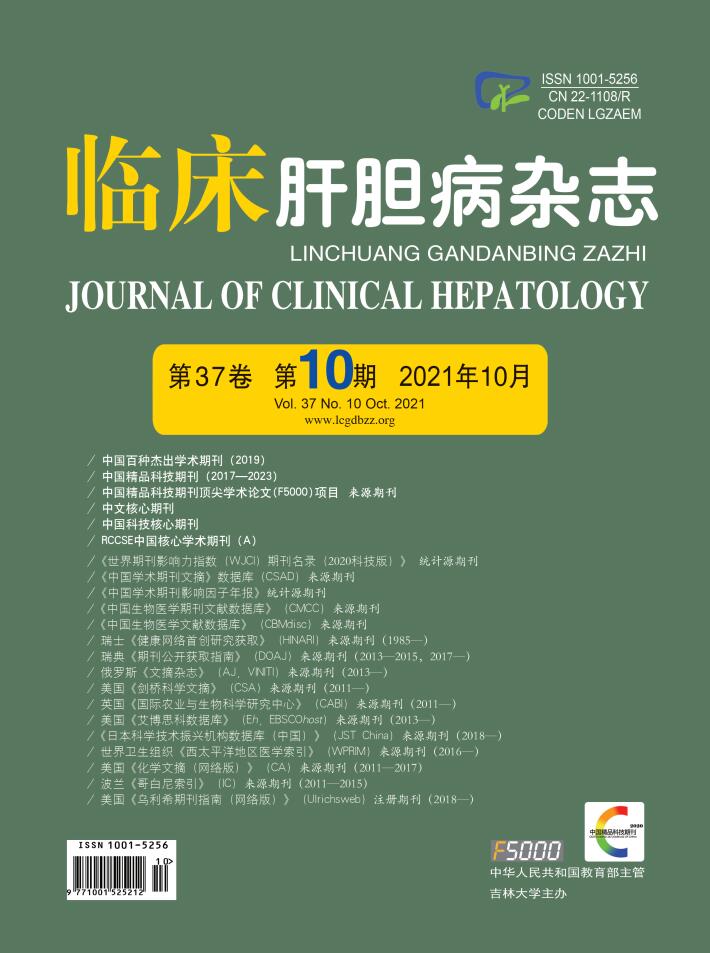| [1] |
|
| [2] |
Tuberculosis Society of Chinese Medical Association. Guidelines for anti-tuberculosis drug-induced liver injury[J]. Chin J Tuberc Respir Dis, 2019, 42(5): 343-356. DOI: 10.3760/cma.j.issn.1001-0939.2019.05.007. |
| [3] |
SHEN T, LIU Y, SHANG J, et al. Incidence and etiology of drug induced liver injury in mainland China[J]. Gastroenterology, 2019, 156: 2230-2241. DOI: 10.1053/j.gastro.2019.02.002. |
| [4] |
SHARMA SK, BALAMURUGAN A, SAHA PK, et al. Evaluation of clinical and immunogenetic risk factors for the development of hepatotoxicity during antituberculosis treatment[J]. Am J Respir Crit Care Med, 2002, 166(7): 916-919. DOI: 10.1164/rccm.2108091. |
| [5] |
van HEST R, BAARS H, KIK S, et al. Hepatotoxicity of rifampin-pyrazinamide and isoniazid preventive therapy and tuberculosis treatment[J]. Clin Infect Dis, 2004, 39(4): 488-496. DOI: 10.1086/422645. |
| [6] |
SHARIFZADEH M, RASOULINEJAD M, VALIPOUR F, et al. Evaluation of patient-related factors associated with causality, preventability, predictability and severity of hepatotoxicity during antituberculosis[correction of antituberclosis] treatment[J]. Pharmacol Res, 2005, 51(4): 353-358. DOI: 10.1016/j.phrs.2004.10.009. |
| [7] |
SAUKKONEN JJ, COHN DL, JASMER RM, et al. An official ATS statement: Hepatotoxicity of antituberculosis therapy[J]. Am J Respir Crit Care Med, 2006, 174(8): 935-952. DOI: 10.1164/rccm.200510-1666ST. |
| [8] |
|
| [9] |
ZHANG T, DU J, YIN X, et al. Adverse events in treating smear-positive tuberculosis patients in China[J]. Int J Environ Res Public Health, 2015, 13(1): 86. DOI: 10.3390/ijerph13010086. |
| [10] |
GE QP, WANG QF, DUAN HF. Clinical analysis of protionamide and para-aminosalicylic acid induced hepatotoxicity in 129 cases[J]. Chin J Tuberc Respir Dis, 2013, 36(10): 737-740. DOI: 10.3760/cma.j.issn.1001-0939.2013.10.008. |
| [11] |
ZHANG MY, LEI JP, YAN SM, et al. Liver injury induced by anti-tuberculosis drugs and anti-tuberculosis therapy for patients with liver disease: Introduction of the experience of diagnosis and treatment in Chinese mainland and "Taiwan Guidelines for TB Diagnosis & Treatment"[J]. J Clin Hepatol, 2015, 31(11): 1776-1781. DOI: 10.3969/j.issn.1001-5256.2015.11.004. |
| [12] |
|
| [13] |
AITHAL GP, WATKINS PB, ANDRADE RJ, et al. Case definition and phenotype standardization in drug-induced liver injury[J]. Clin Pharmacol Ther, 2011, 89(6): 806-815. DOI: 10.1038/clpt.2011.58. |
| [14] |
JIN XL, YANG ZB, ZHAN SH, et al. Influencing factor of liver dysfunction of inpatients of tuberculosis with initial treatment[J/CD]. Chin J Exp Clin Infect Dis(Electronic Edition), 2020, 14(5): 394-400.
金小琳, 杨智彬, 詹淑华, 等. 1501例初治住院结核病患者肝功能异常的影响因素[J/CD]. 中华实验和临床感染病杂志(电子版), 2020, 14(5): 394-400.
|
| [15] |
LI HL, WEN DD, BEI CL, et al. Analysis of anti-tuberculosis drug induced liver injury and its drug use cost in the hospital before and after the special rectification[J]. Chin J Clin Pharmacol Ther, 2019, 24(9): 1030-1036. DOI: 10.12092/j.issn.1009-2501.2019.09.011. |
| [16] |
LEE AM, MENNONE JZ, JONES RC, et al. Risk factors for hepatotoxicity associated with rifampin and pyrazinamide for the treatment of latent tuberculosis infection: Experience from three public health tuberculosis clinics[J]. Int J Tuberc Lung Dis, 2002, 6(11): 995-1000.
|
| [17] |
NOOREDINVAND HA, CONNELL DW, ASGHEDDI M, et al. Viral hepatitis prevalence in patients with active and latent tuberculosis[J]. World J Gastroenterol, 2015, 21(29): 8920-8926. DOI: 10.3748/wjg.v21.i29.8920. |
| [18] |
KIM WS, LEE SS, LEE CM, et al. Hepatitis C and not hepatitis B virus is a risk factor for anti-tuberculosis drug induced liver injury[J]. BMC Infect Dis, 2016, 16: 50. DOI: 10.1186/s12879-016-1344-2. |
| [19] |
LIU YM, CHENG YJ, LI YL, et al. Antituberculosis treatment and hepatotoxicity in patients with chronic viral hepatitis[J]. Lung, 2014, 192(1): 205-210. DOI: 10.1007/s00408-013-9535-8. |
| [20] |
KANEKO Y, NAGAYAMA N, KAWABE Y, et al. Drug-induced hepatotoxicity caused by anti-tuberculosis drugs in tuberculosis patients complicated with chronic hepatitis[J]. Kekkaku, 2008, 83(1): 13-19. http://europepmc.org/abstract/MED/18283910 |
| [21] |
WANG NT, HUANG YS, LIN MH, et al. Chronic hepatitis B infection and risk of antituberculosis drug-induced liver injury: Systematic review and meta-analysis[J]. J Chin Med Assoc, 2016, 79(7): 368-374. DOI: 10.1016/j.jcma.2015.12.006. |
| [22] |
CHEN L, BAO D, GU L, et al. Co-infection with hepatitis B virus among tuberculosis patients is associated with poor outcomes during anti-tuberculosis treatment[J]. BMC Infect Dis, 2018, 18(1): 295. DOI: 10.1186/s12879-018-3192-8. |
| [23] |
ZHENG J, GUO MH, PENG HW, et al. The role of hepatitis B infection in anti-tuberculosis drug-induced liver injury: A meta-analysis of cohort studies[J]. Epidemiol Infect, 2020, 148: e290. DOI: 10.1017/S0950268820002861. |
| [24] |
ZHU CH, ZHAO MZ, CHEN G, et al. Baseline HBV load increases the risk of anti-tuberculous drug-induced hepatitis flares in patients with tuberculosis[J]. J Huazhong Univ Sci Technolog Med Sci, 2017, 37(1): 105-109. DOI: 10.1007/s11596-017-1702-3. |
| [25] |
CHENG SQ. Diagnosis and treatment of coinfection of pulmonary tuberculosis and chronic hepatitis B[J]. World Chin J Dig, 2016, 24(18): 2785-2798. DOI: 10.11569/wcjd.v24.i18.2785. |
| [26] |
TWEED CD, WILLS GH, CROOK AM, et al. Liver toxicity associated with tuberculosis chemotherapy in the REMoxTB study[J]. BMC Med, 2018, 16(1): 46. DOI: 10.1186/s12916-018-1033-7. |
| [27] |
MASINI EO, MANSOUR O, SPEER CE, et al. Using survival analysis to identify risk factors for treatment interruption among new and retreatment tuberculosis patients in Kenya[J]. PLoS One, 2016, 11(10): e0164172. DOI: 10.1371/journal.pone.0164172. |
| [28] |
|
| [29] |
SUN HY, CHEN IL, GAU CS, et al. A prospective study of hepatitis during antituberculous treatment in taiwanese patients and a review of the literature[J]. J Formos Med Assoc, 2009, 108(2): 102-111. DOI: 10.1016/s0929-6646(09)60040-1. |
| [30] |
LEE CM, LEE SS, LEE JM, et al. Early monitoring for detection of antituberculous drug-induced hepatotoxicity[J]. Korean J Intern Med, 2016, 31(1): 65-72. DOI: 10.3904/kjim.2016.31.1.65. |
| [31] |
PATTERSON B, ABBARA A, COLLIN S, et al. Predicting drug-induced liver injury from anti-tuberculous medications by early monitoring of liver tests[J]. J Infect, 2021, 82(2): 240-244. DOI: 10.1016/j.jinf.2020.09.038. |







 DownLoad:
DownLoad: